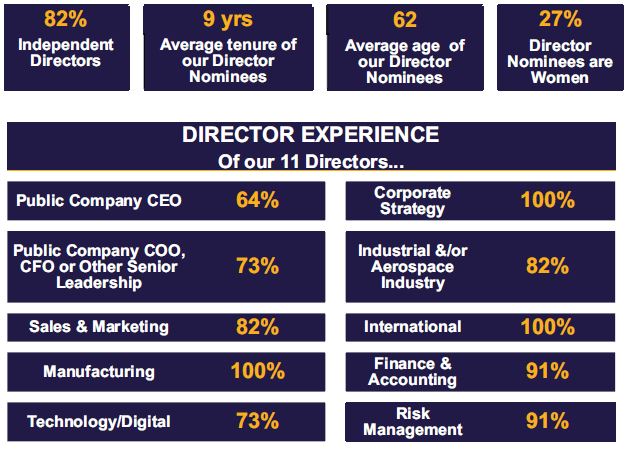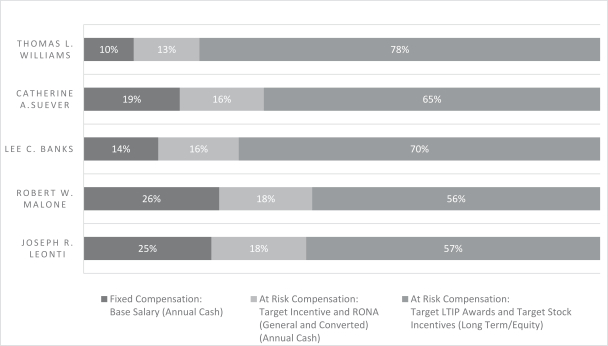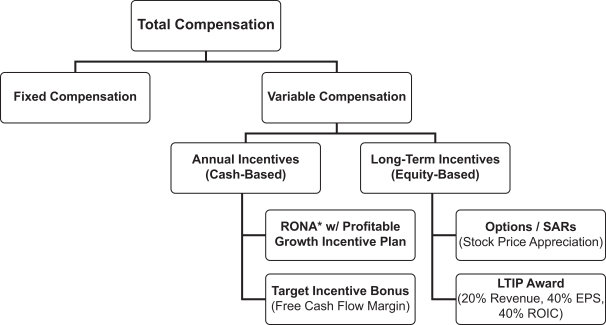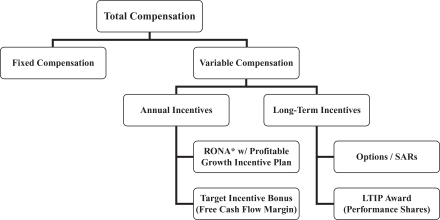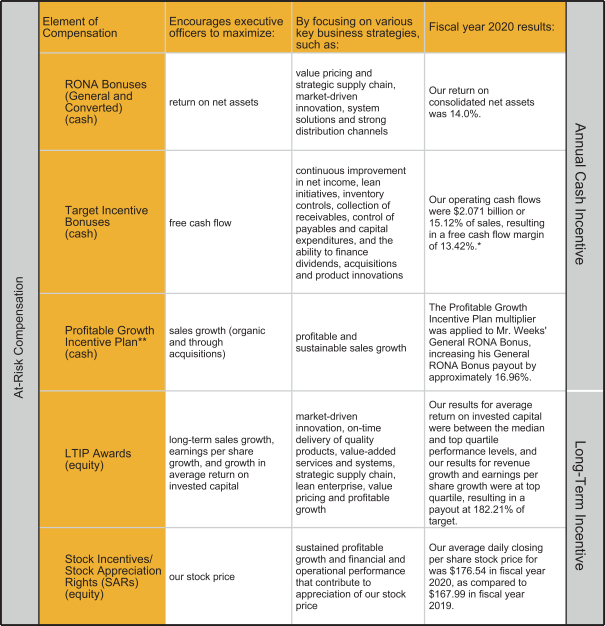HOW TO ATTEND THE ANNUAL MEETING OF SHAREHOLDERS
You mayThe Annual Meeting of Shareholders will only be held virtually via live webcast at:
www.virtualshareholdermeeting.com/PH2020
We have designed the virtual Annual Meeting to provide substantially the same opportunities to participate as you would have at an in-person meeting. There will not be a physical location for the Annual Meeting this year and you will not be able to attend the Annual Meeting in person.
Shareholders of Shareholders if you were a shareholderrecord as of the close of business on August 31, 2018. If youSeptember 4, 2020, the record date, or their legal proxy holders are a registered shareholder or a participant in a retirement or savings plan maintained by us and plan on attending in person, please indicate your intentionentitled to attend by marking the appropriate boxMeeting. To be admitted to the Meeting, you must log-in using the 16-digit control number found on your proxy card. The Annual Meeting will begin promptly at 9:00 a.m. Eastern Daylight Time on Wednesday, October 28, 2020. We encourage you to access the Proxy Card and returning sameAnnual Meeting prior to the start time. Online access will begin at 8:45 a.m. Eastern Daylight Time.
The virtual Annual Meeting but no later than October 22, 2018. platform is fully supported across browsers (Internet Explorer, Firefox, Chrome and Safari) and devices (desktops, laptops, tablets and cell phones) running the most updated version of applicable software and plugins. Shareholders should ensure that they have a strong internet connection if they intend to attend and/or participate in the Annual Meeting. Attendees should allow plenty of time to log-in and ensure that they can hear streaming audio prior to the start of the Annual Meeting.
If you attendencounter any difficulties accessing the virtual Annual Meeting during the check-in or meeting time, please call the technical support number that will be posted on the virtual meeting log-in page for assistance. Technical support will be available beginning at 8:45 a.m. Eastern Daylight Time on Wednesday, October 28, 2020 through the conclusion of the Annual Meeting.
You may submit questions during the Annual Meeting. If you wish to submit a question, you may do so by logging into the virtual meeting platform at www.virtualshareholdermeeting.com/PH2020, entering in your Control Number found on your Proxy Card, typing your question into the “Ask a Question” field, and clicking “Submit”. Additional information regarding the ability of shareholders to ask questions during the Annual Meeting in person, please bring the Admission Card (torn from the top half of your proxy card), along with a proper form of photo identification.
If your shares are heldwill be set forth in the nameMeeting’s Rules of a bank, broker or other nominee and you wish to attendConduct, which will be made available within the virtual Annual Meeting of Shareholders, you must bring proof of ownership, such as an account statement, that clearly shows that you held our common stock as of August 31, 2018, or a legal proxy obtained from your bank, broker or other nominee. Alternatively, you may obtain an Admission Card by sending your request and a copy of your proof of ownership to Corporate Secretary at Parker-Hannifin Corporation, 6035 Parkland Boulevard, Cleveland, Ohio 44124. You must also bring a photo ID.platform.
For security purposes, no cameras, recording equipment, electronic devices, large bags, backpacks, briefcases or packages will be permitted in the meeting room or adjacent areas, and other items will be subject to search.
|
By Order of the Board of Directors |
|
 |
| Joseph R. Leonti |
| Secretary |
September 24, 2018
28, 2020ANNEX A
Parker-Hannifin Corporation
Proxy Access Amendments to Code of Regulations
Article I. Meetings of Shareholders.
[…]
Section 5. Notice of Shareholder Proposals.
(a)Business to Be Conducted at Meetings. At an annual meeting of shareholders, only such business may be conducted as has been properly brought before the meeting. To be properly brought before an annual meeting of shareholders, business (other than the nomination of a person for election as a Director, which is governed by Article I, Section 6, and, to the extent applicable, Article I, Section 7 and Section 8) must be (i) brought before the meeting by or at the direction of the Board of Directors or (ii) otherwise properly brought before the meeting by a shareholder who (A) has complied with all applicable requirements of thisArticle I, Section 5 and Article I, Section 7 in relation to such business, (B) was a shareholder of record of the Corporation at the time of giving the notice and is a shareholder of record of the Corporation at the time of the meeting, and (C) is entitled to vote at the meeting. For the avoidance of doubt, the foregoing clause (ii) will be the exclusive means for a shareholder to submit business before an annual meeting of shareholders (other than proposals properly made in accordance with Rule 14a-8 under the Securities Exchange Act of 1934 (such act, and the rules and regulations promulgated thereunder, the “Exchange Act”), or any successor provision, and included in the notice of meeting given by or at the direction of the Board of Directors). Shareholders shall not be permitted to propose business to be brought before a special meeting of shareholders pursuant to thisArticle I, Section 5(a). Only the person or persons calling a special meeting of shareholders pursuant to Article I, Section 2 may properly bring business before a special meeting of shareholders;provided that business may be brought before a special meeting of shareholders by or at the direction of the Board of Directors, whether or not the Board of Directors has called the special meeting pursuant Article I, Section 2.
(b)Required Form for Shareholder Proposals. To properly bring business before an annual meeting of shareholders in accordance with this Article I, Section 5, a shareholder must deliver written notice to the Secretary of the Corporation that sets forth the following information, which must be updated and supplemented, if necessary, so that the information provided or required to be provided will be true and correct on the record date of the annual meeting and as of such date that is ten business days prior to the annual meeting or any adjournment or postponement thereof; which update shall be delivered to the Secretary of the Corporation promptly and, in no event, later than eight business days prior to the date of the meeting.
(i)Information Regarding the Proposing Person. As to each Proposing Person (as such term is defined inArticle I, Section 7(d)(ii)):
(A) the name and address of such Proposing Person (provided that if the Proposing Person is a holder of record of shares of the Corporation, such Proposing Person shall provide its name as it appears on the Corporation’s share transfer book);
(B) the class, series and number of shares of the Corporation directly or indirectly beneficially owned by such Proposing Person (including any shares of any class or series of the Corporation as to which such Proposing Person has a right to acquire beneficial ownership, whether such right is exercisable immediately or only after the passage of time) and which shares of the Corporation are held of record by the Proposing Person, if any;
(C) a representation (1) that the Proposing Person is a holder of record or beneficial owner of shares of the Corporation entitled to vote at the annual meeting of shareholders (provided that if the Proposing Person is not a holder of record of shares of the Corporation, such Proposing Person shall
submit to the Corporation a written statement from the holder of record of its shares of the Corporation verifying that, at the time it delivered written notice pursuant toArticle I, Section 5(b), it had continually held such shares for at least one year) and intends to appear at the annual meeting (either in person or by agent) to bring such business before the annual meeting and (2) as to whether the Proposing Person intends to deliver a proxy statement and form of proxy related to an applicable proposal to holders of at least the percentage of shares of the Corporation entitled to vote and required to approve the proposal and, if so, identifying such person;
(D) a description of any (1) option, warrant, convertible security, stock appreciation right or similar right or interest (including any derivative securities, as defined under Rule 16a-1 under the Exchange Act, or any successor provision, or other synthetic arrangement having characterization of a long position), either exercisable immediately or only after the passage of time, with an exercise or conversion privilege or a settlement payment or mechanism at a price related to any class or series of securities of the Corporation or with a value derived in whole or in part from the value of any class or series of securities of the Corporation, whether or not such instrument or right is subject to settlement in whole or in part in the underlying class or series of securities of the Corporation or otherwise, directly or indirectly held of record or owned beneficially by such Proposing Person and whether or not such Proposing Person may have entered into transactions that hedge or mitigate the economic effects of such security or instrument and (2) each other direct or indirect right or interest that may enable such Proposing Person to profit or share in any profit derived from, or to manage the risk or benefit from, any increase or decrease in the value of the Corporation’s securities, in each case regardless of whether (w) such right or interest is exercisable immediately or only after the passage of time, (x) such right or interest conveys any voting rights in such security to such Proposing Person, (y) such right or interest is required to be, or is capable of being, settled through delivery of such security, or (z) such Proposing Person may have entered into other transactions that hedge the economic effect of any such right or interest (any such right or interest referred to in this clause (D) being a “Derivative Interest”);
(E) any proxy, contract, agreement, arrangement, understanding or relationship pursuant to which the Proposing Person has a right to vote any shares of the Corporation or that has the effect of increasing or decreasing the voting power of such Proposing Person;
(F) any contract, agreement, arrangement, understanding or relationship including any repurchase or similar so called “stock borrowing” agreement or arrangement, the purpose or effect of which is to mitigate loss, reduce economic risk or increase or decrease voting power with respect to any capital stock of the Corporation or that provides any party, directly or indirectly, the opportunity to profit from any decrease in the price or value of the capital stock of the Corporation;
(G) any material pending or threatened legal proceeding involving the Corporation, any affiliate of the Corporation or any of their respective directors or officers, to which such Proposing Person or its affiliates is a party;
(H) any rights directly or indirectly held of record or beneficially by the Proposing Person to dividends on the shares of the Corporation that are separated or separable from the underlying shares of the Corporation;
(I) any equity interests, including any convertible, derivative or short interests, in any principal competitor of the Corporation;
(J) any performance-related fees (other than an asset-based fee) to which the Proposing Person or any affiliate or immediate family member of the Proposing Person may be entitled as a result of any increase or decrease in the value of shares of the Corporation or Derivative Interests; and
(K) any other information relating to such Proposing Person that would be required to be disclosed in a proxy statement or other filing required pursuant to Section 14(a) of the Exchange Act, or any
successor provision, to be made in connection with a general solicitation of proxies or consents by such Proposing Person in support of the business proposed to be brought before the meeting.
(ii)Information Regarding the Proposal: As to each item of business that the shareholder giving the notice proposes to bring before an annual meeting of shareholders:
(A) a description in reasonable detail of the business desired to be brought before the annual meeting of shareholders and the reasons why such shareholder or any other Proposing Person believes that the taking of the action or actions proposed to be taken would be in the best interests of the Corporation and its shareholders;
(B) a description in reasonable detail of any material interest of any Proposing Person in such business and a description in reasonable detail of all agreements, arrangements and understandings among Proposing Persons or between any Proposing Person and any other person or entity (including their names) in connection with such business; and
(C) the text of any proposal (including the text of any resolutions proposed for consideration) that the shareholder intends to present at the annual meeting.
(c)No Right to Have Proposal Included. A shareholder is not entitled to have a proposal included in the Corporation’s proxy statement and form of proxy solely as a result of such shareholder’s compliance with the provisions of thisArticle I, Section 5.
(d)Requirement to Attend Annual Meeting. If a shareholder does not appear at the annual meeting of shareholders to present its proposal (either in person or by agent), the Board of Directors may direct that the proposal not be presented (notwithstanding that proxies in respect of such proposal may have been solicited, obtained or delivered).
Section 6. Notice of Director Nominations.
(a)General Nomination of Directors. Subject to the rights, if any, of any series of Serial Preferred Stock to nominate or elect Directors, only persons who are nominated by or at the direction of the Board of Directors or in accordance with the procedures set forth in thisArticle I, Section 6or in Article I, Section 8 will be eligible to serve as Directors. Excluding nominations by or at the direction of the Board of Directors or nominations made pursuant to Article I, Section 8 (which governs nominations to be included in the Corporation’s Proxy Materials (as defined in Article I, Section 8(a) below)), all nominations of persons for election as Directors may be made only at an annual meeting of shareholders or a special meeting of shareholders called for the purpose of electing Directors, and, if by a shareholder, only by a shareholder who (Ai) has complied with all applicable requirements of thisArticle I, Section 6 andArticle I, Section 7 in relation to such nomination, (Bii) was a shareholder of record of the Corporation at the time of giving the notice required byArticle I, Section 7(b) and is a shareholder of record of the Corporation at the time of the meeting, and (Ciii) is entitled to vote at the meeting.
(b)Required Form for Director Nominations. To properly nominate a person for election as Director, a shareholder must deliver written notice to the Secretary of the Corporation that sets forth the following information:
(i)Information Regarding the Nominating Person. As to each Nominating Person (as such term is defined inArticle I, Section 7(d)(iii)), the information set forth in Article I, Section 5(b)(i) (except that for purposes of this Section 6, the term “Nominating Person” will be substituted for the term “Proposing Person” in all places where it appears in Article I, Section 5(b)(i) and any reference to “business” or “proposal” therein will be deemed to be a reference to the nomination contemplated by thisArticle I, Section 6).
(ii)Information Regarding the Nominee: As to each person whom the Nominating Person proposes to nominate for election as a Director:
(A) all information with respect to such proposed nominee that would be required to be set forth in a shareholder’s notice pursuant to Article I, Section 5(b)(i) if such proposed nominee were a Nominating Person;
(B) all information relating to such proposed nominee that would be required to be disclosed in a proxy statement or other filing required pursuant to Section 14(a) under the Exchange Act, or any successor provision, to be made in connection with a general solicitation of proxies for an election ofdirectorsDirectors in a contested election (including such proposed nominee’s written consent to be named in the proxy statement as a nominee and to serve as adirectorDirector if elected);
(C) a reasonably detailed description of all direct and indirect compensation and other material monetary agreements, arrangements or understandings during the past three years, any other material relationships, between or among any Nominating Person and its affiliates and associates, or others acting in concert therewith, on the one hand, and each proposed nominee and his or her affiliates, associates or others acting in concert therewith, on the other hand, including all information that would be required to be disclosed pursuant to Items 403 and 404 under Regulation S-K, or any successor provision, if the shareholder giving the notice or any other Nominating Person were the “registrant” for purposes of such rule and the proposed nominee were a director or executive officer of such registrant;
(D) a completed questionnaire (in the form provided by the Secretary of the Corporation upon written request) with respect to the identity, background and qualification of the proposed nominee and the background of any other person or entity on whose behalf the nomination is being made;
(E) a written representation and agreement (in the form provided by the Secretary of the Corporation upon written request) that the proposed nominee (1) is not and will not become a party to (x) any agreement, arrangement or understanding with, and has not given any commitment or assurance to, any person or entity as to how the proposed nominee, if elected as a Director, will act or vote on any issue or question (a “Voting Commitment”) that has not been disclosed to the Corporation or (y) any Voting Commitment that could limit or interfere with the proposed nominee’s ability to comply, if elected as a Director, with the proposed nominee’s fiduciary duties under applicable law, (2) is not and will not become a party to any agreement, arrangement or understanding with any person or entity other than the Corporation with respect to any direct or indirect compensation, reimbursement or indemnification in connection with service or action as a Director that has not been disclosed therein, and (3) if elected as a Director, the proposed nominee would be in compliance and will comply, with all applicable publicly disclosed corporate governance, ethics, conflict of interest, confidentiality andstockshare ownership and trading policies and guidelines of the Corporation.
The Corporation may require any proposed nominee to furnish such other information as may be reasonably required by the Corporation to determine the qualifications and eligibility of such proposed nominee to serve as a Director.
(c)No Right to Have Nominees Included.AExcept as provided by, and subject to compliance with Article I, Section 8, a shareholder is not entitled to have nominees included in the Corporation’s proxy statement solely as a result of such shareholder’s compliance with the foregoing provisions of thisArticle I, Section 6.
(d)Requirement to Attend Meeting. If a shareholder does not appear at the meeting of shareholders to present its nomination, the Board of Directors may direct that such nominee will not stand for election at such meeting (notwithstanding that proxies in respect of such nomination may have been solicited, obtained or delivered).
Section 7. Additional Provisions Relating to the Notice of Shareholder Business and Director Nominations.
(a)Timely Notice.
(i) If it relates to an annual meeting of shareholders, to be timely, a shareholder’s notice required by Article I, Section 5(b) or Article I, Section 6(b) must be delivered to or mailed and received by the Secretary of the Corporation at the principal executive offices of the Corporation not less than 30 nor more than 60 calendar days prior to the first anniversary of the date on which the Corporation held the preceding year’s annual meeting of shareholders; provided that if the date of the annual meeting of shareholders is scheduled for a date more than 30 calendar days prior to or more than 60 calendar days after the anniversary of the preceding year’s annual meeting of shareholders, notice by the shareholder to be timely must be so delivered not later than the close of business on the later of the 30th calendar day prior to such annual meeting and the tenth calendar day following the day on which public disclosure of the date of such meeting is first made. In no event will a recess or adjournment of an annual meeting of shareholders (or any announcement of any such recess or adjournment) commence a new time period (or extend any time period) for the giving of a shareholder’s notice as described above. Notwithstanding the foregoing, in the event the number of Directors to be elected at the annual meeting of shareholders is increased by the Board of Directors, and there is no public announcement by the Corporation naming the nominees for the additional Directors at least 60 calendar days prior to the first anniversary of the date on which the Corporation held the preceding year’s annual meeting of shareholders, a shareholder’s notice pursuant toArticle I, Section 6(b) will be considered timely, but only with respect to nominees for the additional directorships, if it is delivered to or mailed and received by the Secretary of the Corporation at the principal executive offices of the Corporation not later than the close of business on the tenth calendar day following the day on which such public announcement is first made by the Corporation.
(ii) If it relates to a special meeting of shareholders that is called for the purpose of electing Directors, to be timely, a shareholder’s notice required by Article I, Section 6(b) must be delivered to or mailed and received by the Secretary of the Corporation at the principal executive offices of the Corporation promptly after the public disclosure of the date of the meeting and in no event later than five business days after the date of any such public disclosure.
(b)Updating Information in Notice. A shareholder providing notice of business proposed to be brought before a meeting of shareholders pursuant to Article I, Section 5 or notice of any nomination to be made at a meeting of shareholders pursuant to Article I, Section 6 must further update and supplement such notice, if necessary, so that the information provided or required to be provided in such notice pursuant to Article I, Section 5 or Article I, Section 6, as applicable, is true and correct at all times up to and including the date of the meeting (including any date to which the meeting is recessed, adjourned or postponed). Any such update and supplement must be delivered to, or mailed and received by, the Secretary of the Corporation at the principal executive offices of the Corporation, as promptly as practicable.
(c)Determinations of Form, Etc. The presiding officer of any meeting of shareholders will, if the facts warrant, determine that business was not brought in accordance with the procedures prescribed by Article I, Section 5 and this Article I, Section 7 or that a nomination was not made in accordance with the procedures prescribed by Article I, Section 6 and this Article I, Section 7, and if he or she should so determine, he or she will so declare to the meeting and the business or nomination, as applicable, will be disregarded.
(d)Certain Definitions.
(i) For purposes of Article I,Section 5 and Article I, SectionSections 6 and 7, “public disclosure” or “publicly disclosed” means disclosure in a press release reported by the Dow Jones News Service, Bloomberg, Associated Press or comparable national news service or in a document filed by the Corporation with the Securities and Exchange Commission pursuant to Exchange Act or furnished by the Corporation to shareholders.
(ii) For purposes of Article I, Section 5, “Proposing Person” means (A) the shareholder providing the notice of business proposed to be brought before an annual meeting of shareholders, (B) the beneficial
owner or beneficial owners of shares of the Corporation, if different, on whose behalf the notice of the business proposed to be brought before the annual meeting of shareholders is given and (C) any “affiliate” or “associate” (each within the meaning of Rule 12b-2 under the Exchange Act, or any successor provision) of such shareholder or beneficial owner.
(iii) For purposes of Section Article I, Section 6, “Nominating Person” means (A) the shareholder providing the notice of the nomination proposed to be made at an annual meeting of shareholders or at a special meeting of shareholders called for the purpose of electing Directors, (B) the beneficial owner or beneficial owners of shares of the Corporation, if different, on whose behalf the notice of nomination proposed to be made at the annual meeting of shareholders or at a special meeting of shareholders called for the purpose of electing Directors is given and (C) any “affiliate” or “associate” (each within the meaning of Rule 12b-2 under the Exchange Act, or any successor provision) of such shareholder or beneficial owner.
Section 8. Inclusion of Director Nominations by Shareholders in the Corporation’s Proxy Materials.
(a) Subject to the terms and conditions set forth in these Regulations (including the provisions of Article I, Section 6 concerning the general nomination of Directors by shareholders), the Corporation shall include in its proxy statement and form of proxy (hereinafter, the “Proxy Materials”) for an annual meeting of shareholders for the election of Directors, in addition to the persons selected and recommended for election by the Board of Directors or any committee thereof, the name, together with the Required Information (as defined Article I, Section 8(c) below), of any person nominated for election (the “Proxy Access Shareholder Nominee”) to the Board of Directors by one or more shareholders that satisfies the notice, ownership and other requirements of this Article I, Section 8 (such shareholder or group of shareholders, the “Eligible Shareholder”).
(b) To nominate a Proxy Access Shareholder Nominee, the Eligible Shareholder must provide a written notice that expressly elects to have its Proxy Access Shareholder Nominee included in the Proxy Materials pursuant to this Article I, Section 8 (the “Notice of Proxy Access Nomination”). To be timely, the Notice of Proxy Access Nomination must be delivered to the Secretary of the Corporation at the principal executive office of the Corporation not less than 120, nor more than 150, calendar days prior to the anniversary of the date that the Corporation mailed its proxy statement for the prior year’s annual meeting of shareholders (the last day on which a Notice of Proxy Access Nomination may be delivered, the “Final Proxy Access Nomination Date”); provided, however, that if (and only if) there was no annual meeting in the preceding year or the date of the annual meeting is advanced more than 30 calendar days prior to, or delayed by more than 30 calendar days after the anniversary of the preceding year’s annual meeting, to be timely, notice by the Eligible Shareholder must be so delivered not less than 120, nor more than 150, calendar days prior to the date of such annual meeting or, if the first public announcement of the date is less than 130 calendar days prior to the date of such annual meeting, by the 10th calendar day following the day on which such public announcement is made. In addition to the other requirements set forth in this Article I, Section 8, the Notice of Proxy Access Nomination must include the name and address of the Eligible Shareholder (including each shareholder and beneficial owner whose share ownership is counted for the purposes of qualifying as an Eligible Shareholder).
(c) For purposes of this Article I, Section 8, the “Required Information” that the Corporation will include in the Proxy Materials is (i) the information concerning the Proxy Access Shareholder Nominee and the Eligible Shareholder that the Corporation determines is required to be disclosed in the Proxy Materials under the Exchange Act; and (ii) if the Eligible Shareholder so elects, a Statement (as defined in Article I, Section 8(h) below). Nothing in this Article I, Section 8 shall limit the Corporation’s ability to solicit against and include in the Proxy Materials its own statements relating to any Proxy Access Shareholder Nominee.
(d) The maximum number of Proxy Access Shareholder Nominees (including Proxy Access Shareholder Nominees that were submitted by Eligible Shareholders for inclusion in the Proxy Materials pursuant to this Article I, Section 8 but either are subsequently withdrawn or that the Board of Directors decides to select and recommend as Director nominees under Article I, Section 6 of these Regulations) that may appear in the Proxy Materials with respect to an annual meeting of shareholders shall not exceed the greater of (i) two or (ii) 20% of
the number of Directors in office as of the Final Proxy Access Nomination Date (or if such number is not a whole number, the closest whole number below 20%) (the “Permitted Number”); provided, however, that the Permitted Number shall be reduced by the number of incumbent Directors who had been a Proxy Access Shareholder Nominee with respect to any of the preceding two annual meetings of shareholders and whose reelection at the upcoming annual meeting is being recommended by the Board of Directors; provided, further, that in the event that one or more vacancies for any reason occurs on the Board of Directors at any time after the Final Proxy Access Nomination Date and before the date of the applicable annual meeting of shareholders and the Board of Directors reduces the size of the Board of Directors in connection therewith, the Permitted Number shall be calculated based on the number of Directors in office as so reduced. In the event that the number of Proxy Access Shareholder Nominees submitted by Eligible Shareholders pursuant to this Article I, Section 8 exceeds the Permitted Number, each Eligible Shareholder will select one Proxy AccessShareholder Nominee for inclusion in the Proxy Materials until the Permitted Number is reached, with preference provided based on the number (largest to smallest) of shares owned by each Eligible Shareholder as disclosed in each Notice of Proxy Access Nomination. If the Permitted Number is not reached after each Eligible Shareholder has selected one Proxy Access Shareholder Nominee, this selection process will continue as many times as necessary, following the same order each time, until the Permitted Number is reached.
(e) An Eligible Shareholder is one or more shareholders who owns and has owned, or is or are acting on behalf of one or more beneficial owners who own and have owned (as defined in Article I, Section 8(f) below), for at least three years as of the date the Notice of Proxy Access Nomination is received by the Corporation, shares representing at least 3% of the shares of the Corporation outstanding as of the most recent date for which such number is disclosed by the Corporation in any filing by the Corporation with the Securities and Exchange Commission prior to submission of the Notice of Proxy Access Nomination (the “Required Shares”), and who continue to own the Required Shares at all times between the date the Notice of Proxy Access Nomination is received by the Corporation and the date of the applicable annual meeting of shareholders, provided that the aggregate number of such shareholders and beneficial owners shall not exceed 20. Two or more funds that are (i) under common management and investment control, (ii) under common management and funded primarily by a single employer or (iii) a “group of investment companies,” as such term is defined in Section 12(d)(1)(G)(ii) of the Investment Company Act of 1940, as amended (such funds together under each of (i), (ii) or (iii) comprising a “Qualifying Fund”) shall be treated as one shareholder for the purpose of determining the aggregate number of shareholders in this Article I, Section 8(e), and treated as one person for the purpose of determining ownership in Article I, Section 8(f), provided that each fund comprising a Qualifying Fund otherwise meets the requirements set forth in this Article I, Section 8. No shareholder or beneficial owner may be a member of more than one group constituting an Eligible Shareholder under this Article I, Section 8. Should any shareholder or beneficial owner withdraw from a group of Eligible Shareholders at any time prior to the annual meeting of shareholders, the group of Eligible Shareholders shall only be deemed to own the shares held by the remaining members of the group.
(f) For purposes of calculating the Required Shares, “ownership” shall be deemed to consist of and include only the outstanding shares as to which a person possesses both (i) the full voting and investment rights pertaining to the shares and (ii) the full economic interest in (including the opportunity for profit and risk of loss on) such shares; provided that the ownership of shares calculated in accordance with clauses (i) and (ii) shall not include any shares (A) that a person has sold in any transaction that has not been settled or closed, (B) that a person has borrowed or purchased pursuant to an agreement to resell or (C) subject to any option, warrant, forward contract, swap, contract of sale, other derivative or similar agreement entered into by a person, whether any such instrument or agreement is to be settled with shares or with cash based on the notional amount or value of shares, in any such case which instrument or agreement has, or is intended to have, the purpose or effect of (1) reducing in any manner, to any extent or at any time in the future, the person’s full right to vote or direct the voting of any such shares, or (2) hedging, offsetting or altering to any degree gain or loss arising from the full economic ownership of such person’s shares. Ownership shall include shares held in the name of a nominee or other intermediary so long as the person claiming ownership of such shares retains the right to instruct how the shares are voted with respect to the election of Directors and possesses the full economic interest in the shares, provided that this provision shall not alter the obligations of any shareholder to provide the Notice of Proxy
Access Nomination. Ownership of shares shall be deemed to continue during any period in which shares have been loaned if the person claiming ownership has the power to recall such loaned shares on five business days’ notice and the person recalls the loaned shares within five business days of being notified that its Proxy Access Shareholder Nominee will be included in the Proxy Materials for the applicable annual meeting, and the person holds the recalled shares through such annual meeting. Ownership of shares shall be deemed to continue during any period in which any voting power has been delegated by means of a proxy, power of attorney or other instrument or arrangement which is revocable at any time without condition. For purposes of this Article I, Section 8, the determination of the extent of ownership of shares shall be made in good faith by the Board ofDirectors, which determination shall be conclusive and binding on the Corporation and the shareholders. An Eligible Shareholder shall include in its Notice of Proxy Access Nomination the number of shares it is deemed to own for the purposes of this Article I, Section 8.
(g) No later than the Final Proxy Access Nomination Date, an Eligible Shareholder (including each shareholder, Qualifying Fund and beneficial owner whose share ownership is counted for the purposes of qualifying as an Eligible Shareholder) must provide the following information in writing to the Secretary of the Corporation:
(i) all of the information required pursuant to Article I, Section 6(b) as if the Notice of Proxy Access Nomination were a shareholder’s notice with respect to nominations of persons for election of Directors pursuant to Article I, Section 6(b);
(ii) one or more written statements from the record holder of the shares (and from each intermediary through which the shares are or have been held during the requisite three-year holding period) verifying that, as of a date within seven calendar days prior to the date the Notice of Proxy Access Nomination is sent to the Corporation, the Eligible Shareholder owns, and has owned continuously for the preceding three years, the Required Shares, and the Eligible Shareholder’s agreement to provide (A) within five business days after (1) the record date for the applicable annual meeting (if, prior to such record date, the Corporation (x) disclosed such record date by press release or any filing with the Securities and Exchange Commission or (y) delivered a written notice of the record date (including by electronic mail) to the Eligible Shareholder) or (2) the date on which the Corporation disclosed such record date by press release or any filing with the Securities and Exchange Commission (if such record date is a date that precedes such disclosure), written statements from the record holder and intermediaries verifying the Eligible Shareholder’s continuous ownership of the Required Shares through the record date, and (B) immediate notice if the Eligible Shareholder ceases to own any of the Required Shares prior to the date of the applicable annual meeting of shareholders (for purposes of this clause (ii), “record holder” shall mean the applicable Depositary Trust Company (“DTC”) participant for shares that are deposited at DTC);
(iii) the written consent of each Proxy Access Shareholder Nominee to being named in the Proxy Materials as a nominee and to serving as a Director if elected; and
(iv) a copy of the Schedule 14N that has been filed with the Securities and Exchange Commission as required by Rule 14a-18 under the Exchange Act.
In addition, no later than the Final Proxy Access Nomination Date, an Eligible Shareholder (including each shareholder, Qualifying Fund and beneficial owner whose share ownership is counted for purposes of qualifying as an Eligible Shareholder) must provide to the Secretary of the Corporation a signed and written:
(i) representation of the Eligible Shareholder that such Eligible Shareholder (A) acquired the Required Shares in the ordinary course of business and not with the intent to change or influence control of the Corporation, and does not presently have such intent, (B) intends to maintain qualifying ownership of the Required Shares through the date of the applicable annual meeting of shareholders, (C) has not nominated and will not nominate for election to the Board of Directors at the applicable annual meeting of shareholders any person other than its Proxy Access Shareholder Nominee, (D) has not engaged and will not engage in, and has not and will not be a “participant” in another person’s, “solicitation” within the meaning of Rule
14a-1(l) under the Exchange Act in support of the election of any individual as a Director at the applicable annual meeting of shareholders other than its Proxy Access Shareholder Nominee(s) or a nominee of the Board of Directors, (E) will not distribute to any shareholder any form of proxy for the applicable annual meeting of shareholders other than the formdistributed by the Corporation, and (F) will provide facts, statements and other information in all communications with the Corporation and its shareholders that are or will be true and correct in all material respects and do not and will not omit to state a material fact necessary in order to make the statements made, in light of the circumstances under which they were made, not misleading and otherwise will comply with all applicable laws, rules and regulations in connection with any actions taken pursuant to this Article I, Section 8;
(ii) in the case of a nomination by a group of shareholders that together constitutes an Eligible Shareholder, designation by all such group members of one group member that is authorized to act on behalf of all members of the nominating shareholder group with respect to the nomination and matters related thereto, including withdrawal of the nomination; and
(iii) undertaking that the Eligible Shareholder agrees to (A) assume all liability stemming from any legal or regulatory violation arising out of the Eligible Shareholder’s communications with the shareholders of the Corporation or out of the information that the Eligible Shareholder provided to the Corporation, (B) indemnify and hold harmless the Corporation and each of its Directors, officers and employees individually against any liability, loss or damages in connection with any threatened or pending action, suit or proceeding, whether legal, administrative or investigative, against the Corporation or any of its Directors, officers or employees arising out of any nomination, solicitation or other activity by the Eligible Shareholder in connection with its efforts to elect the Proxy Access Shareholder Nominee pursuant to this Article I, Section 8, and (C) file with the Securities and Exchange Commission any solicitation with the Corporation’s shareholders relating to the meeting at which the Proxy Access Shareholder Nominee will be nominated, regardless of whether any such filing is required under Regulation 14A of the Exchange Act or whether any exemption from filing is available for such solicitation under Regulation 14A of the Exchange Act.
In addition, no later than the Final Proxy Access Nomination Date, a Qualifying Fund whose share ownership is counted for purposes of qualifying as an Eligible Shareholder must provide to the Secretary of the Corporation documentation reasonably satisfactory to the Board of Directors that demonstrates that the funds comprising the Qualifying Fund are either (i) under common management and investment control, (ii) under common management and funded primarily by a single employer or (iii) a “group of investment companies,” as such term is defined in Section 12(d)(1)(G)(ii) of the Investment Company Act of 1940, as amended.
(h) The Eligible Shareholder may provide to the Secretary of the Corporation, at the time the information required by this Article I, Section 8 is provided, a written statement for inclusion in the Proxy Materials for the applicable annual meeting of shareholders, not to exceed 500 words, in support of the Eligible Shareholder’s Proxy Access Shareholder Nominee (the “Statement”). Notwithstanding anything to the contrary contained in this Article I, Section 8, the Corporation may omit from the Proxy Materials any information or Statement (or portion thereof) that it, in good faith, believes would violate any applicable law or regulation.
(i) No later than the Final Proxy Access Nomination Date, each Proxy Access Shareholder Nominee must:
(i) provide to the Secretary of the Corporation all of the consents, representations, and agreements required pursuant to Article I, Section 6 as if the Proxy Access Shareholder Nominee was a nominee;
(ii) submit to the Secretary of the Corporation all completed and signed documents required of the Corporation’s Directors and nominees for election to the Board of Directors within five business days of receipt of each such questionnaire from the Corporation; and
(iii) provide to the Secretary of the Corporation within five business days of the Corporation’s request such additional information as the Corporation determines may be necessary to permit the Board of Directors to determine (A) such Proxy Access Shareholder Nominee’s status as to “independence”,
including references to the criteria established by the New York Stock Exchange (or any other exchange or quotation system on which the Corporation’s equity securities are listed), any applicable rules of the Securities and Exchange Commission and the Corporation’s Corporate Governance Guidelines and Independence Standards for Directors, (B) if such Proxy Access Shareholder Nominee has any direct or indirect relationship with the Corporation, and (C) if such Proxy Access Shareholder Nominee is not and has not been subject to any event specified in Item 401(f) of Regulation S-K of the Exchange Act or any successor provision.
In the event that any information or communications provided by the Eligible Shareholder or the Proxy Access Shareholder Nominee to the Corporation or its shareholders ceases to be true and correct in any respect or omits a fact necessary to make the statements made, in light of the circumstances under which they were made, not misleading, each Eligible Shareholder or Proxy Access Shareholder Nominee, as the case may be, shall promptly notify the Secretary of the Corporation of any such inaccuracy or omission in such previously provided information and of the information that is required to make such information or communication true and correct.
(j) Any Proxy Access Shareholder Nominee who is included in the Proxy Materials for a particular annual meeting of shareholders but either (i) withdraws from or becomes ineligible or unavailable for election at that annual meeting, or (ii) does not receive at least 25% of the votes cast in favor of the Proxy Access Shareholder Nominee’s election, will be ineligible to be a Proxy Access Shareholder Nominee pursuant to this Article I, Section 8 for the next two annual meetings of shareholders. Any Proxy Access Shareholder Nominee who is included in the Proxy Materials for a particular annual meeting of shareholders, but subsequently is determined not to satisfy the eligibility requirements of this Article I, Section 8 or any other provision of these Regulations, or the Corporation’s Articles of Incorporation, Corporate Governance Guidelines, Independence Standards for Directors or other applicable document or regulation at any time before the applicable annual meeting of shareholders, will not be eligible for election at the relevant annual meeting of shareholders and may not be substituted by the Eligible Shareholder that nominated such Proxy Access Shareholder Nominee.
(k) The Corporation shall not be required to include, pursuant to this Article I, Section 8, a Proxy Access Shareholder Nominee in the Proxy Materials for any meeting of shareholders, or, if the proxy statement already has been filed, to allow the nomination of a Proxy Access Shareholder Nominee, notwithstanding that proxies in respect of such vote may have been received by the Corporation:
(i) if any person is engaging in a “solicitation” within the meaning of Rule 14a-1(l) under the Exchange Act in support of the election of any individual as a Director at the applicable annual meeting of shareholders other than a nominee of the Board of Directors;
(ii) if the Proxy Access Shareholder Nominee or the Eligible Shareholder (or any member of any group of shareholders that together is such Eligible Shareholder) who has nominated such Proxy Access Shareholder Nominee has engaged in or is currently engaged in, or has been or is a “participant” in another person’s, “solicitation” within the meaning of Rule 14a-1(l) under the Exchange Act in support of the election of any individual as a Director at the applicable annual meeting of shareholders other than its Proxy Access Shareholder Nominee(s) or a nominee of the Board of Directors;
(iii) who is not independent under the listing standards of each principal U.S. securities exchange upon which the common shares of the Corporation are listed, any applicable rules of the Securities and Exchange Commission, and any publicly disclosed standards used by the Board ofDirectors in determining and disclosing independence of the Corporation’s Directors, in each case as determined by the Board of Directors;
(iv) who does not meet the audit committee independence requirements under the rules of any U.S. securities exchange upon which the common shares of the Corporation are traded, is not a “non-employee director” for the purposes of Rule 16b-3 under the Exchange Act (or any successor rule), is not an “outside director” for the purposes of Section 162(m) of the Internal Revenue Code (or any successor provision);
(v) whose election as a member of the Board of Directors would cause the Corporation to be in violation of these Regulations, the Articles of Incorporation, the rules and listing standards of the principal
U.S. securities exchanges upon which the common shares of the Corporation are listed, or any applicable state or federal law, rule or regulation;
(vi) who is or has been, within the past three years, an officer or director of a competitor, as defined in Section 8 of the Clayton Antitrust Act of 1914;
(vii) who is a named subject of a pending criminal proceeding (excluding traffic violations and other minor offenses) or has been convicted in such a criminal proceeding within the past ten years;
(viii) if such Proxy Access Shareholder Nominee or the applicable Eligible Shareholder (or any member of any group of shareholders that together is such Eligible Shareholder) shall have provided information to the Corporation in connection with such nomination, including information provided pursuant to this Article I, Section 8, that was untrue in any material respect or omitted to state a material fact necessary in order to make any statement made, in light of the circumstances under which it was made, not misleading, as determined by the Board of Directors or any committee thereof;
(ix) the Eligible Shareholder (or a qualified representative thereof) does not appear at the applicable annual meeting of shareholders to present the Proxy Access Shareholder Nominee for election;
(x) the Eligible Shareholder (or any member of any group of shareholders that together is such Eligible Shareholder) or applicable Proxy Access Shareholder Nominee otherwise breaches or fails to comply with or the Board of Directors or any committee thereof determines it has breached its representations or obligations pursuant to these Regulations, including, without limitation, this Article I, Section 8; or
(xi) the Eligible Shareholder ceases to be an Eligible Shareholder for any reason, including but not limited to not owning the Required Shares through the date of the applicable annual meeting.
For the purpose of this Section 8(k): (A) clauses (ii) through (xi) will result in the exclusion from the Proxy Materials pursuant to this Article I, Section 8 of the specific Proxy Access Shareholder Nominee to whom the ineligibility applies, or, if the proxy statement already has been filed, the ineligibility of the Proxy Access Shareholder Nominee; and (B) clause (i) may, at the sole discretion of the Board of Directors, result in the exclusion from the Proxy Materials pursuant to this Article I, Section 8 of all or any number of Proxy Access Shareholder Nominees from the applicable annual meeting of Shareholders, or, if the proxy statement already has been filed, the ineligibility of all Proxy Access Shareholder Nominees.
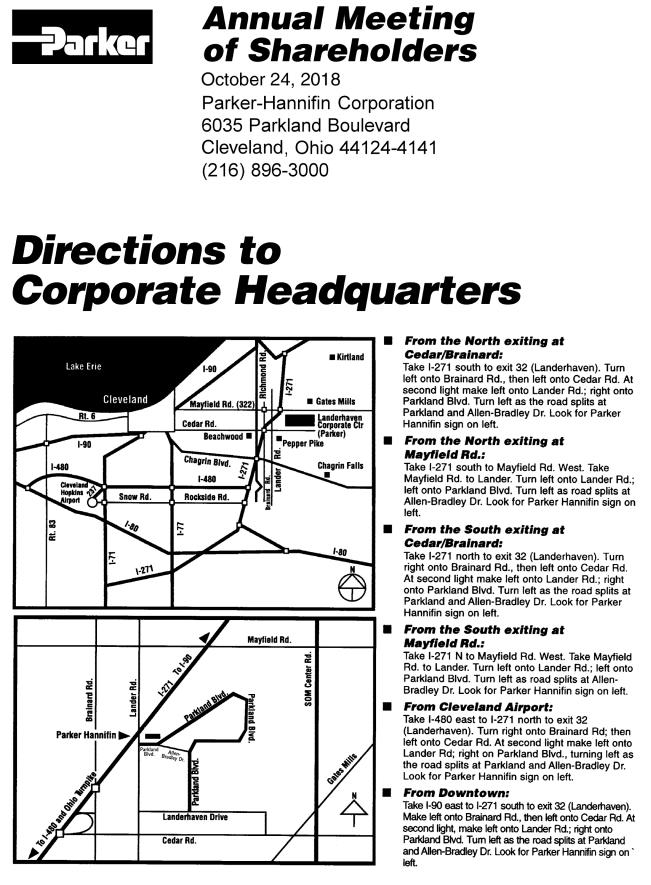
| | |
| Parker-Hannifin Corporation | | 2020 Proxy Statement ◆ 81 |








